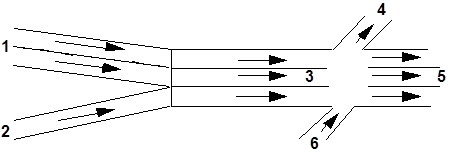Traffic States¶
The traffic demand data in a Traffic State is composed of the input flows at the input sections of the network and the turn proportions at every node of the network. Both can be defined by vehicle type. These data can be obtained as a result of a previous assignment model, from observed data collected by detectors or defined by the user as an experimental hypothesis.
Traffic States can be only used in vehicle based simulators (Micro, Meso or Hybrid) and stochastic route choice path selection models, but not in static assignments which require OD matrices.
Vehicle Generation and Movement¶
Vehicles are generated and input into the network through the input sections, following a random generation model based on the mean input flows for those sections. They are then distributed randomly throughout the network in accordance with the turn proportions defined at each section of the network. This means that vehicles do not “know” their complete path through the network or their destination, they only "know" about their next three turning movements.
At each point in the network, each vehicle will have a cache of its planned movement at the next three nodes or four sections including the one it is on. This knowledge allows the vehicle to make the appropriate lane choice on each section based on the Aimsun lane changing model. The cache is then updated as the vehicle crosses a node when the turning movement three nodes ahead will be decided from their turn proportions and the node cache updated. This is true for connector nodes as well as junction nodes.
Aimsun Next can distinguish between the different entrances to a section, so different turn proportions can be defined. Each turn proportion will affect only the vehicles entering the section from each different entrance. The next figure gives an example of this. Section 3 has two possible entrances: sections 1 and 2. Therefore, the turn proportions for section 3 to sections 4 and 5 can be different for vehicles coming from section 1 to those coming from section 2. The same happens with section 5, whose entrances are sections 3 and 6.

Intervals between arrivals are determined from the mean flows of the input sections, applying any of the random distributions explained in the Traffic Generation section . Vehicle type is assigned as a function of the proportions defined for each section. The input lane depends on the state of all lanes composing the section, the existence of reserved lanes and the vehicle type. Rightmost lanes (or leftmost lanes, depending on the Rule of the Road) are more likely to be used than central lanes.
A Traffic State is composed of those input flows and turn proportions for a time slice, for a vehicle type.
Creating a Traffic State¶
Use the New…/ Demand data / Traffic State option in the Project menu, the Demand Data folder’s context menu or the Traffic States folder context menu of the Project Window to create a new Traffic State.
For a new Traffic State, a name will be assigned following the convention ‘state vehType: initialTime duration’ (for example, ‘state car: 08:00 01:00’). When any of these parameters changes, the name will be automatically updated, unless the state name is edited in which case the edited name will be retained. Auto naming will be re-activated if the user supplied name is deleted.
Traffic State Editor¶
The traffic state editor is used to define the traffic state properties. Open it by double clicking on the desired traffic state in the Project Window.

In the Main tab, the vehicle type, the initial time and the duration of the traffic state are defined.
In the Input Flow tab, the flows entering each section that is entrance point to the network can be specified.
In the Turn Info tab, all the turn percentages from a section to all the sections accessible from it are defined. This folder shows all sections, or only sections where the percentages are relevant, that is, sections with more than one turn. The turn percentage can take into account where the flow into the current section came from. If the preceding section must be taken into account when allocating the flow, select the section in the editor and click the Use Input Turns button. If not, select the section and press the Don’t Use Input Turns button again.

Alternately, the exit flows can be defined instead of turn percentages when these values are available. If the exit flows are specified, then the turn percentages can be automatically calculated using the Recalculate Turn Percentage using Exit Flows button. Note that the simulator will not take into account the turn flows defined; it will use the turn percentages.
For example, when a traffic state is created using the flow information of a static traffic assignment both the turn percentages and the turn flows are known.
The Highlight incorrect definitions checkbox activates coloring on the first column of the table. The cells will remain “uncolored” when the turn percentages are correctly defined; they will be painted in red when the sum of the turn percentages coming from a section is not equal to 100; and will be painted in orange when no value is entered in the table for all the turns coming from a same section. This orange highlighting does not necessarily mean the definition is wrong, but it will be interpreted as if 100% of flow was assigned to the first turn and 0% to the remaining turns.
Finally, in this editor, as in the OD matrix editor, values can be copied into or pasted from an external spreadsheet application using the Copy/Paste buttons, and some parameters such as the day of the week, weather, season, event and methodology used to calculate the traffic state can be set.